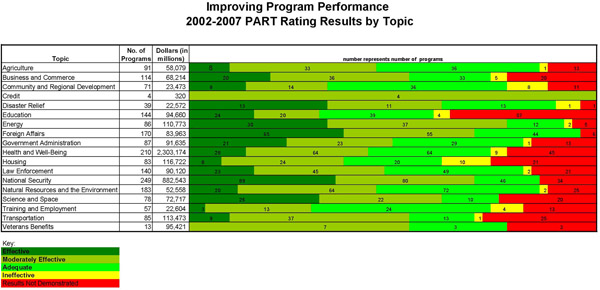
|
The Performance Improvement Initiative
In August, once again we posted the latest round of Program Assessment Rating Tool (PART) assessments to ExpectMore.gov. The bottom line:
Some of the high performing programs you can find at ExpectMore.gov: High Intensity Drug Trafficking Areas (HIDTA): The HIDTA program improved the way it measures success by implementing a system for tracking and analyzing performance data. Using this information, more drug trafficking organizations were dismantled for less money. In 2005, 2,183 Drug Trafficking Organizations were dismantled for $80,000 each. By 2006, 2,332 were dismantled for $76,000 each. Administration on Aging: The Administration on Aging (AoA) improved its outreach and services to elderly Americans who suffer from disease and disability. The number of States serving elderly individuals living below the poverty level significantly increased from eight in 2003 to 20 in 2005. Over 300,000 elderly and disabled individuals, who due to their physical conditions would be living in nursing homes, can continue to live in their own homes and stay connected to their communities. In 2003, this number totaled around 280,000. As Clay Johnson put it at the time of the release: "Our ultimate goal is to make programs work better. Today, we have more information about what works and what doesn't than ever before, and we expect agencies will continue to improve as agencies, the Administration, and Congress make greater use about this information." One of the best uses agencies and programs can make of this information is to look at programs similar to their own and learn from the best. We've never been able to do that before, but now we can. ExpectMore.gov lets you search for programs by type or topic. Below you can see how they break out by rating, and on ExpectMore.gov, you can learn what programs are doing to achieve their goals.
That's agencies - but what about Congress. The United States Senate actually took time out to debate PART. Senator Wayne Allard introduced an amendment to cut ineffective programs funded in the Labor, HHS, and Education Appropriations Bill by 10 percent across the board. In advocating his amendment, Senator Allard said: These assessments represent the combined wisdom of career officials. This is not a political process. These are objective evaluations done by career officials at agencies and OMB, and are based on evidence of that program's performance. While a program's overall rating should not be the sole determinant of funding, Congress should prioritize funding programs that perform well. Ineffective programs in particular should be scrutinized to determine whether the resources they use could be better spent elsewhere and whether their goals could be achieved through other means. Senator Allard brought warranted focus on programs that aren't performing as they should. In arguing against the amendment, Senator Tom Harkin said: [T]he Program Assessment Rating Tool . . . is intended to help assess the management and performance of individual programs. So it is not just a question of whether the program works, it also evaluates whether Congress has designed the program in a clear manner and whether Federal agencies do a good job managing the program. Regardless of one's view of Senator Allard's amendment, the debate on the amendment was an important one. Both Senators went on to have a substantive debate about how programs were performing and how to get them to perform better. But that wasn't all. Senator Cornyn, in defending his own amendment, told his Senate colleagues and the American people: The Office of Management and Budget has recently reviewed over a thousand programs. As this chart indicates, upon a review of 1,016 Federal Government programs, they have concluded that 22 percent of those programs rated either as ineffective or they are unable to determine whether they are effective. In other words, they are unable to find evidence that they are effective. They have not conclusively determined them as ineffective, but they have concluded that 22 percent of the Federal Government programs are either ineffective or the results are not demonstrated. Anybody who is interested anywhere in the world--certainly in the United States - can look at the information on this expectmore.gov Web site and inform themselves, as I am sure they would want to, about what the Federal Government is doing and not doing on their behalf. These debates are remarkable. Rarely does the Senate take time out during floor debates to discuss the best ways to incentivize programs to perform better. I hope this rash of debates continues. If it does, it only means good things for program performance. |
